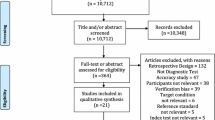Abstract
Purpose
It is widely accepted that although valuable in the diagnosis of the discoid meniscus and tears, magnetic resonance imaging (MRI) can be insufficient in determining the type of the tear. This study calculates the sensitivity and specificity of MRI in determining the presence and absence of tears and how these values differ for different types of tears.
Methods
This study is a retrospective review of 10 years of our experience with arthroscopic discoid meniscus treatment between 1999 and 2009. MRI findings were compared with the intraoperative arthroscopic findings in 52 patients with 50 lateral and two medial discoid menisci of which 24 were complete and 28 were incomplete. Tears were classified into six groups: (1) no tear, (2) simple horizontal tear, (3) radial tear, (4) combined horizontal tear, (5) complex tear and (6) longitudinal tear. Sensitivity, specificity, positive and negative predictive values of MRI were calculated for each group separately and for the presence and absence of tears in general. In addition, the effect of age, type of discoid meniscus, and presence and absence of shift on the distribution of tear types were analysed.
Results
MRI was found to be 100 % specific and 97.8 % sensitive for determining the presence or absence of a tear with a negative predictive value of 85.7 % and a positive predictive value of 100 %. The specificities were 80 % for simple horizontal, 50 % for radial, 66.7 % for combined horizontal, 55.6 % for complex and 14.3 % for longitudinal tears, whereas the sensitivities were 66.7 % for simple horizontal, 96.9 % for radial, 87.5 % for combined horizontal, 94.6 % for complex and 100 % for longitudinal tears. The presence and absence of shift and type of the discoid were found to affect the distribution of the tear type.
Conclusions
MRI is successful in determining the presence or absence of tears in discoid menisci; however, its ability to determine the tear type is questionable. Complete discoid menisci were found to have tendency towards having a simple horizontal or longitudinal tear, whereas incomplete discoid menisci tend to have radial or combined horizontal tears. Determination of the shift prior to surgery is important since it alters the surgical technique.
Level of evidence
I.


Similar content being viewed by others
References
Ahn JH, Lee YS, Ha HC, Shim JS, Lim KS (2009) A novel magnetic resonance imaging classification of discoid lateral meniscus based on peripheral attachment. Am J Sports Med 37(8):1564–1569
Aichroth PM, Patel DV, Marx CL (1991) Congenital discoid lateral meniscus in children. A follow-up study and evolution of management. J Bone Joint Surg Br 73(6):932–936
Atay OA, Doral MN, Leblebicioglu G, Tetik O, Aydingoz U (2003) Management of discoid lateral meniscus tears: observations in 34 knees. Arthroscopy 19(4):346–352
Atay OA, Pekmezci M, Doral MN, Sargon MF, Ayvaz M, Johnson DL (2007) Discoid meniscus: an ultrastructural study with transmission electron microscopy. Am J Sports Med 35(3):475–478
Bellier G, Dupont JY, Larrain M, Caudron C, Carlioz H (1989) Lateral discoid menisci in children. Arthroscopy 5(1):52–56
Bin SI, Kim JC, Kim JM, Park SS, Han YK (2002) Correlation between type of discoid lateral menisci and tear pattern. Knee Surg Sports Traumatol Arthrosc 10(4):218–222
Dickason JM, Del Pizzo W, Blazina ME, Fox JM, Friedman MJ, Snyder SJ (1982) A series of ten discoid medial menisci. Clin Orthop Relat Res 168:75–79
Hayashi LK, Yamaga H, Ida K, Miura T (1988) Arthroscopic meniscectomy for discoid lateral meniscus in children. J Bone Joint Surg Am 70(10):1495–1500
Jordan MR (1996) Lateral meniscal variants: evaluation and treatment. J Am Acad Orthop Surg 4(4):191–200
Kim YG, Ihn JC, Park SK, Kyung HS (2006) An arthroscopic analysis of lateral meniscal variants and a comparison with MRI findings. Knee Surg Sports Traumatol Arthrosc 14(1):20–26
Mayer-Wagner S, von Liebe A, Horng A, Scharpf A, Vogel T, Mayer W, Jansson V, Glaser C, Muller PE (2011) Discoid lateral meniscus in children: magnetic resonance imaging after arthroscopic resection. Knee Surg Sports Traumatol Arthrosc 19(11):1920–1924
Pellacci F, Montanari G, Prosperi P, Galli G, Celli V (1992) Lateral discoid meniscus: treatment and results. Arthroscopy 8(4):526–530
Rao PS, Rao SK, Paul R (2001) Clinical, radiologic, and arthroscopic assessment of discoid lateral meniscus. Arthroscopy 17(3):275–277
Ryu KN, Kim IS, Kim EJ, Ahn JW, Bae DK, Sartoris DJ, Resnick D (1998) MR imaging of tears of discoid lateral menisci. Am J Roentgenol 171(4):963–967
Smith CF, Van Dyk GE, Jurgutis J, Vangsness CT Jr (1999) Cautious surgery for discoid menisci. Am J Knee Surg 12(1):25–28
Sun Y, Jiang Q (2011) Review of discoid meniscus. Orthop Surg 3(4):219–223
Watanabe M, Takeda S, Ikeuchi H (1979) Atlas of arthroscopy, 3rd edn. Igaku-Shoin, Tokyo, pp 87–91
Watson-Jones R (1930) Specimen of internal semilunar cartilage as a complete disc. Proc R Soc Med 23:588
Yoo WJ, Lee K, Moon HJ, Shin CH, Cho TJ, Choi IH, Cheon JE (2012) Meniscal morphologic changes on magnetic resonance imaging are associated with symptomatic discoid lateral meniscal tear in children. Arthroscopy 28(3):330–336
Young R (1889) The external semilunar cartilage as a complete disc. In: Cleland J, Mackay J, Young R (eds) Memoirs and memoranda in anatomy. Williams and Norgate, London, p 179
Author information
Authors and Affiliations
Corresponding author
Rights and permissions
About this article
Cite this article
Yilgor, C., Atay, O.A., Ergen, B. et al. Comparison of magnetic resonance imaging findings with arthroscopic findings in discoid meniscus. Knee Surg Sports Traumatol Arthrosc 22, 268–273 (2014). https://doi.org/10.1007/s00167-013-2371-9
Received:
Accepted:
Published:
Issue Date:
DOI: https://doi.org/10.1007/s00167-013-2371-9




